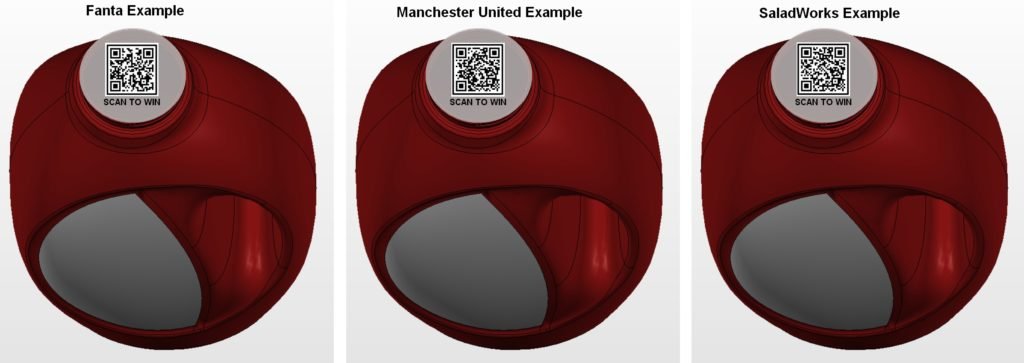A cap liner is a piece of material that sits between the cap and the bottle. Its traditional primary purposes are to offer proper sealing of the product to prevent leakage and optionally to provide tamper evidence.
New technology is now turning this humble piece of packaging into a multimedia gateway for brands to reach out to their consumers through the Tribe Platform.
Since the cap liner is something only seen by the consumer after the product has been opened, the cap liner can essentially facilitate a “cap coupon”.

Since the cap liner is in direct contact with the product, chemical compatibility and correct certification for contact with your kind of product is crucial. Using the wrong seal can lead to expensive and sometimes dangerous mistakes that can jeopardize your product brand and integrity.
Chemical products and consumer/food products can require liners that differ significantly in their properties. The varying liner materials have different jobs. They may be used as any combination of moisture barriers, oxygen barriers, chemical resistant barriers, consumer tamper evidence safety and for preventing leakage.
The cap liner material alone can significantly affect the cost of the cap, not to mention the impact on the finished product.
Compatibility of the caps, liners and bottles has to be tested; as well as the compatibility of these packaging materials to the product inside.
Selecting the Right Seal
Novice producers may find it difficult to decide which cap liner is the right solution for their product. With all the different liner types available, choosing the correct liner for your product and container is an important step. If considering cap lining material it may be worthwhile looking at how a practical packaging initiative and a practical marketing initiative can be combined.
A wide range of cap seals are available but by focusing on these key questions, we should be able to narrow down the field:
- Level of tamper evidence required?
- Type of product: liquid, powder, or solid?
- After opening the product is a reseal important?
- Will the Seal be used to promote the Brand?
Some Popular Cap Liners
- Plain Expanded PE foam. Providing both a seal and reseal, this is one of the lowest cost cap lining materials available. When produced using C02 Gas the cell structure of this material can be tight and present and perform close to that of some laminated foams produced with less sophisticated methods.
- Laminated Expanded PE foam. As per the Plain foam this material has added layers often on both sides to provide a smoother and more chemically resistant sealing surface. With the right laminates this material can have Good resistance to acid, alkalis, solvents, alcohols, oils, household cosmetics, and aqueous products. Aluminum, Tin or Saran are common coatings used for alcohol with Tin being particularly popular for Wine bottles with screw caps.
- Pressure Seal Foam Liner. Coated with torque-activated adhesive, the action of applying the cap causes this seal to bond with the bottle or product opening; there is no need for an outside heat source. Historically this type of seal was applied to provide tamper evidence and often printed with words that would infer that the seal was a form of tamper evidence. You will now notice that on any credible supplier’s specification sheet they will go out of their way to state this is NOT a seal to provide tamper evidence. This is to avoid potential legal claims associated with the possibility this type of seal can be tampered with and reapplied without any special equipment. The Moisture and oxygen barrier of this type of material is also generally lower than laminated foams.
- Induction Liners – When passed through an induction process, the foil layer heats up in a process that will bond all or part of the lining material to the top of the product. Induction liners can only be applied using an Induction Sealing Machine.
There are 2 types of Induction Liners:
- One-piece Foil. Since it “sticks” to the bottle after sealing, this single-use foil is one of the most common forms of sealing. Side tabs and Lift ‘n’ Peel™ options add to the experience of easy removal from the lid for items like milk and juices. An added barrier layer can also provide protection against aggressive products. An air and watertight hermetic seal prevents leakage in packaging for edible oils, water, juices, condiments, shampoos & conditioners, gasoline treatments, additives, food & beverages, nutraceutical products, health & beauty products, vitamins, spices, and pharmaceutical products. Often a one piece Foil will need to be applied over a softer and thicker foam based liner to insure a good distribution of pressure from the cap over the entire opening of the product to be sealed.
- Two-piece Heat Induction Liner – The benefit of using two-piece heat induction liners is that they eliminate the need for lining the closure in two separate stages: The base foam or cardboard layer of the liner is temporarily bonded to the foil with either a wax and paper layer or a separating polymer layer.





